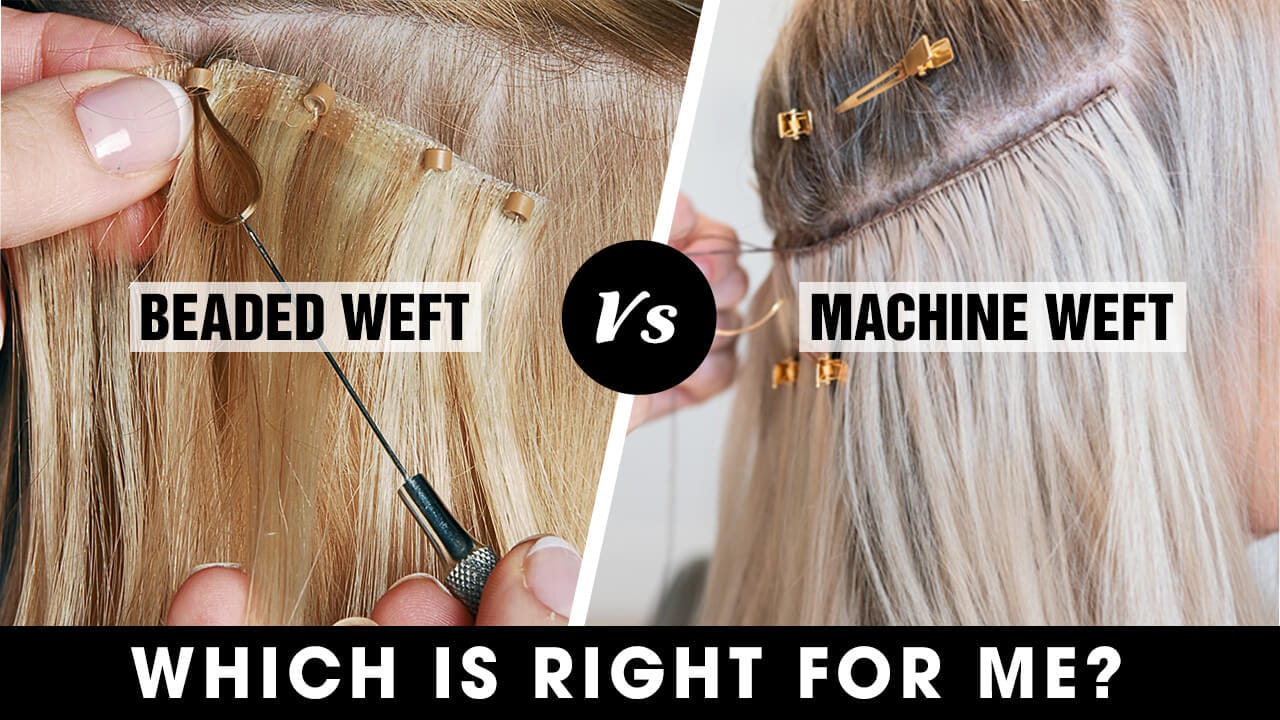Beaded Weft Vs. Machine Weft: Which is Right for Me?

It is very hard to say there are big differences between beaded wefts and machine wefts. In general, Machine wefts are consist of large amount of extensions types such as beaded wefts.
However, when it comes to the installation method, beaded weft is quite different from machine wefts. Therefore, when we try to compare the two hair extensions, in general we are speaking of the installation methods.
Key Takeaways
-
Beaded wefts are light and mix well with thin hair. They are great if you want a natural style.
-
Machine wefts cost less and make hair look fuller. But they can feel heavy and are less hidden on thin hair.
-
Think about your hair type and daily routine before picking extensions. Ask a stylist for advice that fits you best.
What Are Beaded Weft Extensions?
Beaded weft extensions are light and look very natural. They are tied by hand to a fabric strip. Small silicone beads attach them to your hair. This method is gentle and helps protect your hair. It’s a good choice if you want healthy hair growth with extensions.
Beaded wefts are very flexible and easy to style. You can wear your hair up or down without trouble. They are light and won’t pull on your hair. This makes them comfy for daily use. If your hair is thin or fine, they blend well and look real.
What Are Machine Weft Extensions
Machine weft extensions are made with special sew in machines. These machines sew hair into thick, strong strips. It quite similar to beaded weft extensions as both of them have the strong strips. The very difference is beaded weft has silicone beaded ring on top of the wefts which make it is possible to pull your hair through the ring.
Stylists can cut these strips to fit your needs. They are heavier and thicker at the base than beaded wefts. This can sometimes pull on your hair roots.
If your hair is thick or coarse, machine wefts work well. They add more volume and suit heavier hair types. But they might not be great for thin hair. The weight could feel uncomfortable or harm your hair over time.
Benefits and Drawbacks of Beaded Weft and Machine Weft
Advantages of Beaded Weft
Beaded wefts have many good things about them. They let you try fun hairstyles, like big updos or new colors. These extensions mix well with your real hair, so they look natural. The beading method is gentle and doesn’t use heat or glue. This keeps your hair safe from damage. Stylists can also adjust them to match your hair perfectly, giving you a great look.
Beaded wefts are strong and can last for months if cared for. They are quick to put in, which is great if you’re busy. Since they are light, they don’t make your hair feel heavy.
Disadvantages of Beaded Weft
Even though beaded wefts are great, they have some downsides. You need to tighten the beads often to keep them in place. If not done right, they might tangle or slip out. They can also cost more at first compared to other extensions. This might be a problem if you’re trying to save money.
Advantages of Machine Weft
Machine wefts are great for adding thickness to your hair. They are strong and work well for people with thick or coarse hair. One of the biggest advantages for machine weft is they cost you less than beaded weft. Since they are made by machines, they are even and can be cut to fit your head. If you care much about the cost and time,machine weft is the perfect choice for you.
Disadvantages of Machine Weft
Machine wefts can feel heavy, especially if your hair is thin. This weight might hurt your hair or feel uncomfortable over time.
They don’t blend as well as beaded wefts, so they might be easier to notice. Some hairstyles are harder to do because of their thick base.
If you are the person who cares about looks more natural, machine wefts might not be the best choice.
How To Install Beaded Weft
The beaded weft installation process is precise but straightforward.
Step 1,Your stylist will start by sectioning your hair horizontally, beginning at the nape of your neck. They’ll secure the rest of your hair with clips to keep it out of the way.
Step 2,they’ll thread small silicone-lined beads onto sections of your natural hair. These beads are then clamped securely using pliers to create a sturdy base.
Step 3,Once the beads are in place, the stylist will sew the hand-tied weft onto the beaded row. This step ensures the extensions stay in place while lying flat against your scalp.
The process is repeated for additional rows, depending on how much volume or length you want.
Finally, the stylist will trim and style the extensions to blend seamlessly with your natural hair. This method is gentle and avoids heat or glue, making it a great choice for maintaining healthy hair.
How To Install Machine Weft
Installing machine weft extensions is a bit different.
Step 1, The stylist begins by parting your hair horizontally and securing the sections with clips.
Step 2, They’ll then sew the machine weft directly onto braided sections of your natural hair or onto a track created with adhesive. This method is faster than beaded weft installation, but it can feel heavier due to the thicker base of the wefts.
Step 3, Sometimes you stylist will cut the machine weft to fit your head, ensuring a snug fit. However, the thicker base may not lie as flat against your scalp, which could make them more noticeable. After the wefts are secured, the stylist will blend them with your natural hair for a polished look.
How To Take Care of Beaded Weft
Caring for beaded wefts helps them last longer and look nice.
-
Wash them 2-3 times a week with warm water and sulfate-free shampoo.
-
Don’t scrub the bead areas directly; rinse gently around them.
-
On days you don’t wash, use dry shampoo to keep your hair fresh.
-
After washing, pat your hair dry with a towel. Let it air dry, or use a blow dryer on low heat with a diffuser if needed.
-
Brush your extensions 2-3 times daily with a special extension brush to stop tangles.
-
Before sleeping, tie your hair in a loose braid or bun.
-
Use a silk pillowcase to avoid friction.
-
Stay away from chlorine or saltwater, as they can harm the extensions.
How To Take Care of Machine Weft
Machine wefts need similar care but with small changes.
-
Use sulfate-free shampoo and conditioner to keep them soft and healthy.
-
Wash your hair 2-3 times a week, and make sure the wefts are fully dry before bed. Wet wefts can tangle or weaken over time.
-
Limit using heat tools to protect the wefts. If you use heat, spray on a heat protector first.
-
Brush gently with a looped or special extension brush to avoid pulling on the thick base.
-
Regular care keeps machine wefts looking thick and smooth.
How Long Extensions Last
How long your extensions last depends on how you care for them.
Beaded wefts usually last 6-12 months. You’ll need to move them up every 6-8 weeks as your hair grows. Avoid harsh products and too much heat to make them last longer.
Machine wefts also last 6-12 months, depending on their quality and your care. Their thicker base makes them strong, but rough styling or poor care can shorten their life. Follow a good care routine to keep your extensions in great shape for as long as possible.
How Much Are Beaded Weft And Machine Weft Cost
Initial Costs
Machine weft extensions usually cost less at first. They are made in large amounts, which lowers their price. If you don’t want to spend much, machine wefts are a good choice. Beaded wefts, however, cost more upfront. They are handmade and take more time to put in.
Even though beaded wefts cost more, they offer great quality. They look natural and mix well with your hair. If you care about comfort and a natural look, the higher price is worth it.
Long-Term Benefits
Over time, beaded wefts can save you money. They last longer and don’t need to be replaced often. Machine wefts, however, wear out faster and may cost more in the long run. If you want durable extensions, beaded wefts are a better pick.
Budget Choices
Your budget matters when choosing between these extensions. If you want a quick, cheap way to add volume, go for machine wefts. But if you want high-quality extensions that protect your hair, choose beaded wefts. Think about how often you’ll use them and how much care they need. This will help you pick the right extensions for your needs and budget.
Picking between beaded weft and machine weft extensions depends on your needs. Beaded weft extensions are light, easy to hide, and very flexible. They’re great for thin or fine hair and are comfy to wear. On the other hand, machine weft extensions are better for thick hair and add lots of volume. Think about your hair type, what you want, and your daily routine. To make the best choice, ask a stylist for advice. They can help based on your hair’s texture and condition.
Pro Tip: Take good care of beaded weft extensions to make them last longer. They’re a smart choice if you want a natural look for a long time.
FAQ
What is the difference between hand-tied and machine weft extensions?
Hand-tied wefts are lightweight and discreet, perfect for fine hair. Machine wefts are thicker and sturdier, ideal for adding volume to coarse or thick hair.
Can I style my extensions with heat tools?
Yes, you can use heat tools on both types. Always apply a heat protectant to prevent damage and maintain the extensions' quality.
How often should I move up my extensions?
You should move them up every 6-8 weeks as your hair grows. This keeps them secure and looking natural.










